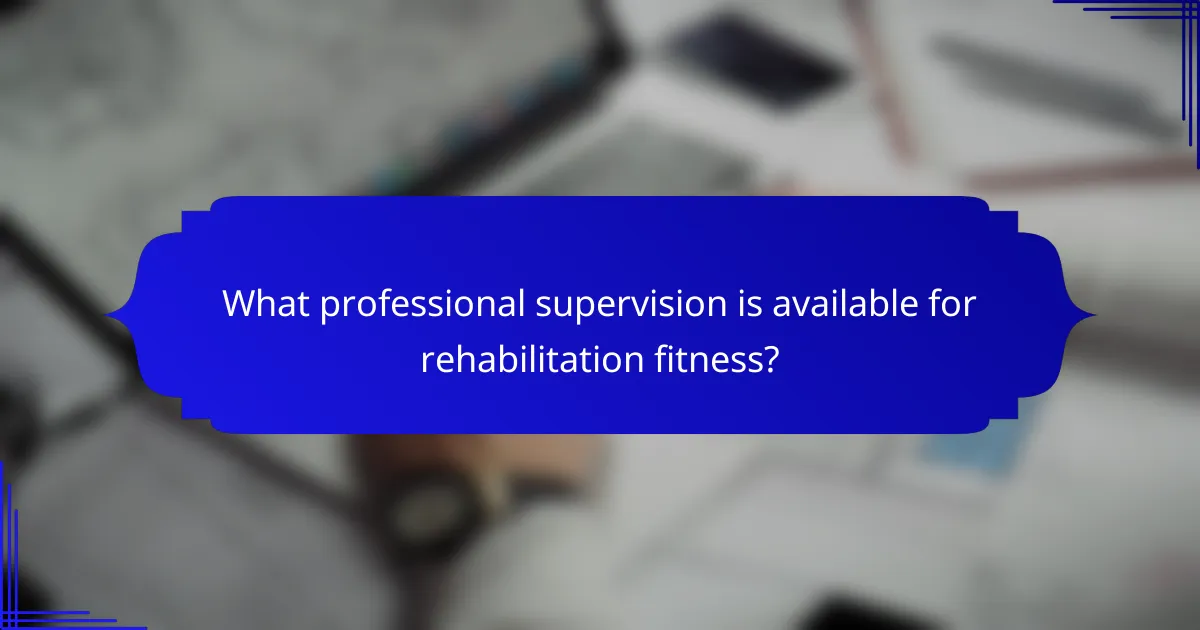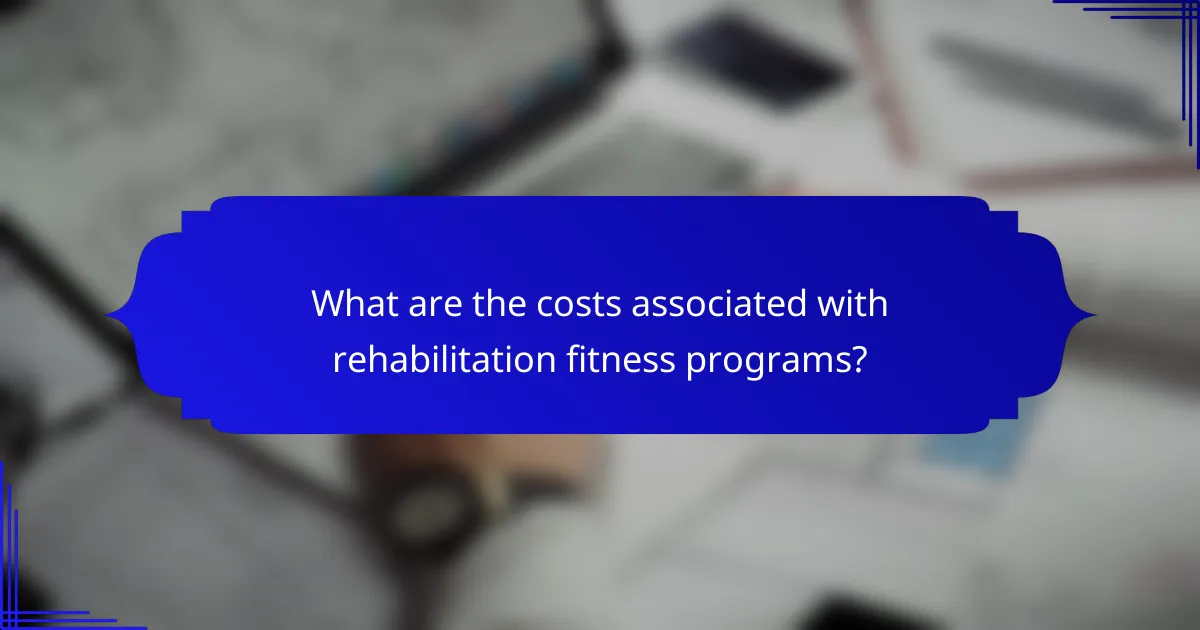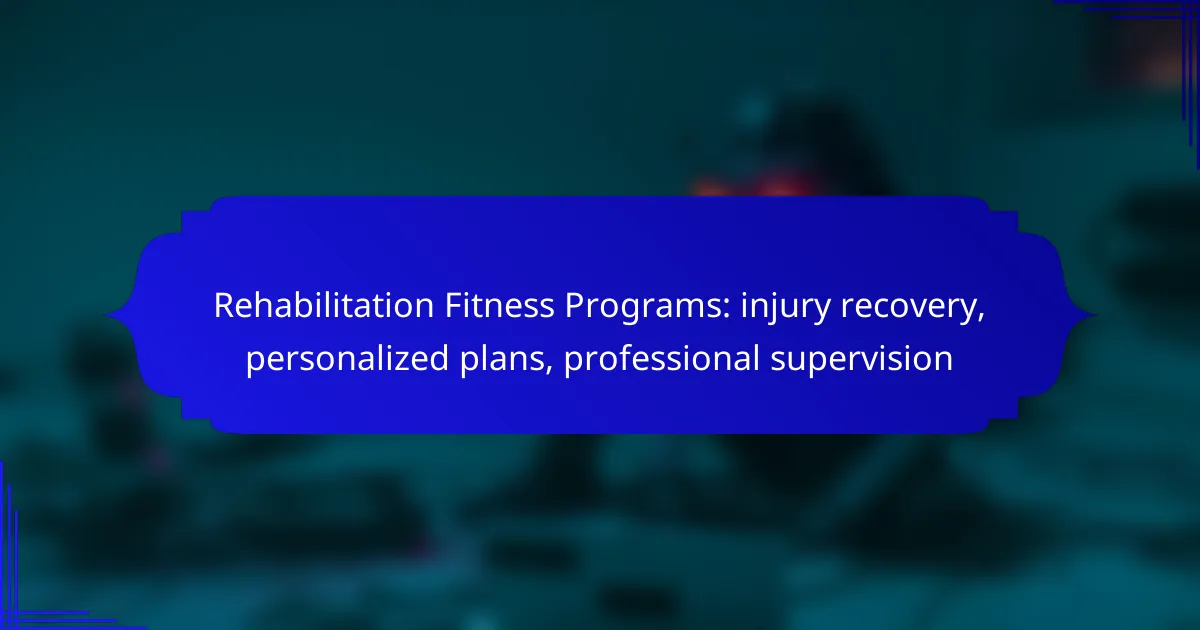Rehabilitation fitness programs are essential for effective injury recovery, offering personalized plans that cater to individual needs and goals. With professional supervision, these programs ensure safe and targeted exercises, promoting not only recovery but also overall fitness and injury prevention. Tailored strategies help individuals navigate their rehabilitation journey with confidence and support.

What are the best rehabilitation fitness programs in Canada?
The best rehabilitation fitness programs in Canada focus on personalized recovery plans, professional supervision, and targeted exercises. These programs are designed to help individuals recover from injuries while improving their overall fitness and preventing future issues.
Active Rehabilitation Programs
Active rehabilitation programs emphasize movement and exercise to aid recovery. These plans typically involve a combination of strength training, flexibility exercises, and cardiovascular activities tailored to the individual’s injury and fitness level.
Participants often work with a certified trainer or physiotherapist who monitors their progress and adjusts the program as needed. This hands-on approach ensures that exercises are performed safely and effectively, maximizing recovery outcomes.
Physiotherapy-Integrated Fitness Plans
Physiotherapy-integrated fitness plans combine traditional physiotherapy with fitness training. These programs are designed for individuals recovering from injuries or surgeries, ensuring that rehabilitation exercises align with fitness goals.
In Canada, many clinics offer these integrated plans, allowing patients to transition smoothly from rehabilitation to regular fitness routines. This continuity helps maintain motivation and encourages long-term health benefits.
Sports-Specific Recovery Programs
Sports-specific recovery programs are tailored for athletes recovering from injuries related to their sport. These programs focus on exercises that mimic the movements and demands of the specific sport, promoting faster and more effective recovery.
For example, a runner might engage in specific strength and flexibility exercises to address common running injuries. These targeted approaches help athletes return to their sport stronger and more resilient.
Group Rehabilitation Classes
Group rehabilitation classes provide a supportive environment for individuals recovering from injuries. These classes often combine various exercises and activities, fostering camaraderie among participants while promoting accountability.
Led by qualified instructors, these sessions can help participants stay motivated and engaged in their recovery process. Group settings also allow for shared experiences, which can enhance emotional support during rehabilitation.
Online Rehabilitation Coaching
Online rehabilitation coaching offers flexibility for individuals seeking recovery support from home. These programs typically involve virtual consultations with trained professionals who design personalized fitness plans and provide ongoing guidance.
While online coaching can be convenient, it’s essential to ensure that the program includes regular check-ins and assessments to track progress. This approach allows for adjustments to the plan as needed, ensuring effective recovery while accommodating individual schedules.

How do personalized rehabilitation plans work?
Personalized rehabilitation plans are tailored strategies designed to aid individuals in recovering from injuries through targeted exercises and professional guidance. These plans are built around an individual’s specific needs, goals, and physical capabilities, ensuring an effective recovery process.
Initial Assessment and Goal Setting
The first step in creating a personalized rehabilitation plan involves an initial assessment conducted by a qualified professional. This assessment evaluates the individual’s injury, physical condition, and overall health status.
Based on the findings, specific recovery goals are established. These goals may include regaining strength, improving flexibility, or returning to a particular sport or activity. Setting realistic and measurable objectives is crucial for tracking progress.
Customized Exercise Regimens
Following the assessment, a customized exercise regimen is developed to address the individual’s unique needs. This regimen typically includes a mix of strength training, flexibility exercises, and cardiovascular activities tailored to promote healing.
For instance, someone recovering from a knee injury might focus on low-impact exercises like swimming or cycling, gradually increasing intensity as their condition improves. The plan should be adaptable, allowing for modifications based on the individual’s recovery pace.
Progress Tracking and Adjustments
Regular progress tracking is essential to ensure the rehabilitation plan remains effective. Professionals monitor improvements in strength, mobility, and pain levels, adjusting the regimen as needed to align with the individual’s recovery trajectory.
Common adjustments may involve increasing exercise intensity, introducing new exercises, or altering the frequency of sessions. Consistent communication between the individual and the rehabilitation team helps identify any challenges and celebrate milestones throughout the recovery process.

What professional supervision is available for rehabilitation fitness?
Professional supervision in rehabilitation fitness includes guidance from trained experts to ensure safe and effective recovery from injuries. This supervision is crucial for creating personalized fitness plans that accommodate individual needs and limitations.
Certified Physiotherapists
Certified physiotherapists play a vital role in rehabilitation fitness by assessing injuries and developing tailored exercise programs. They utilize techniques such as manual therapy and modalities to alleviate pain and improve mobility.
During sessions, physiotherapists monitor progress and adjust plans as necessary, ensuring that patients are performing exercises correctly to avoid further injury. They often work in collaboration with other healthcare professionals to provide a comprehensive recovery approach.
Exercise Physiologists
Exercise physiologists specialize in designing exercise programs that enhance physical function and promote recovery. They focus on the physiological responses to exercise and tailor fitness regimens to meet the specific needs of individuals recovering from injuries.
These professionals often conduct fitness assessments to determine a safe starting point and set realistic goals. They provide ongoing support and motivation, helping clients stay committed to their rehabilitation journey.
Rehabilitation Specialists
Rehabilitation specialists oversee the entire recovery process, coordinating care among various professionals, including physiotherapists and exercise physiologists. They ensure that all aspects of a patient’s rehabilitation are aligned and that the recovery plan is comprehensive.
These specialists often have advanced training in specific injury types and can offer insights into the latest rehabilitation techniques. They are essential for creating a cohesive strategy that addresses both physical and psychological aspects of recovery.

What are the benefits of rehabilitation fitness programs?
Rehabilitation fitness programs offer numerous benefits, including improved physical function, reduced pain, and enhanced mental health. These programs are tailored to individual needs, ensuring effective recovery under professional supervision.
Improved Mobility and Strength
One of the primary benefits of rehabilitation fitness programs is the enhancement of mobility and strength. Through targeted exercises, individuals can regain lost function and build muscle, which is crucial for daily activities. A typical program may include strength training, flexibility exercises, and balance work, all designed to progressively challenge the body.
For instance, patients recovering from knee surgery might engage in specific leg exercises to rebuild strength and improve joint mobility. Regular assessments help adjust the program to ensure continued progress.
Reduced Pain and Discomfort
Rehabilitation fitness programs can significantly alleviate pain and discomfort associated with injuries or chronic conditions. By incorporating gentle movements and therapeutic exercises, these programs promote healing and reduce inflammation. Techniques such as stretching, low-impact aerobics, and aquatic therapy are often utilized to minimize strain while enhancing recovery.
Individuals may notice a decrease in pain levels within a few weeks of consistent participation. It is essential to communicate any discomfort to the supervising professional to modify the program as needed.
Enhanced Mental Well-being
Engaging in rehabilitation fitness programs can lead to improved mental well-being. Physical activity releases endorphins, which can elevate mood and reduce feelings of anxiety or depression. Additionally, the structured environment of these programs provides social interaction and support, which are vital for emotional health during recovery.
Setting and achieving fitness goals can also boost self-esteem and motivation. Participants are encouraged to celebrate small victories, fostering a positive mindset throughout their rehabilitation journey.

How to choose the right rehabilitation fitness program?
Choosing the right rehabilitation fitness program involves understanding your specific recovery needs and finding a program that aligns with those requirements. Look for personalized plans that offer professional supervision to ensure safe and effective recovery.
Assessing Individual Needs
Start by evaluating your injury type and recovery goals. Consider factors such as your current fitness level, any limitations, and the timeline for recovery. A thorough assessment by a healthcare professional can help identify the best approach tailored to your situation.
Additionally, think about any previous rehabilitation experiences. Reflecting on what worked well or what didn’t can guide you in selecting a program that meets your unique needs.
Evaluating Program Credentials
Check the qualifications of the professionals overseeing the program. Look for certifications in rehabilitation, physical therapy, or exercise science. Programs led by licensed practitioners often ensure adherence to safety and effectiveness standards.
Research the program’s track record. Testimonials and success stories from previous participants can provide insight into the program’s efficacy. Consider programs that have a history of helping individuals with similar injuries.
Considering Location and Accessibility
Location plays a crucial role in your ability to consistently attend sessions. Choose a program that is conveniently located, whether it’s near your home or workplace. This reduces the likelihood of skipping sessions due to travel difficulties.
Accessibility also includes the availability of facilities and equipment. Ensure the program has the necessary resources to support your rehabilitation, such as specialized equipment and a supportive environment for recovery.

What are the costs associated with rehabilitation fitness programs?
The costs of rehabilitation fitness programs can vary widely based on factors such as location, type of service, and duration. Generally, individuals can expect to pay for personalized plans, professional supervision, and any additional therapies required during recovery.
Average Pricing for In-Person Sessions
In-person rehabilitation fitness sessions typically range from around $50 to $150 per hour, depending on the expertise of the professional and the complexity of the program. Sessions with specialized therapists or trainers may cost more, particularly in urban areas.
Many facilities offer package deals, which can reduce the per-session cost. For example, purchasing a package of ten sessions might lower the average price to about $40 to $120 per session, providing a more economical option for ongoing rehabilitation.
Insurance coverage can also impact out-of-pocket expenses. Some health insurance plans may cover a portion of rehabilitation services, so it’s advisable to check with your provider for specific details regarding coverage and co-pays.
